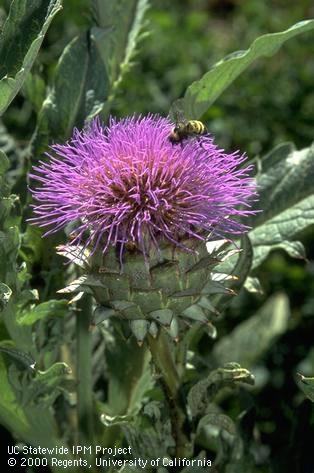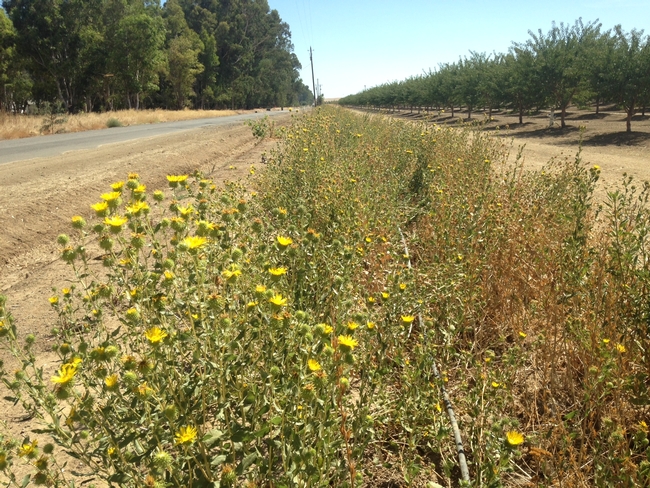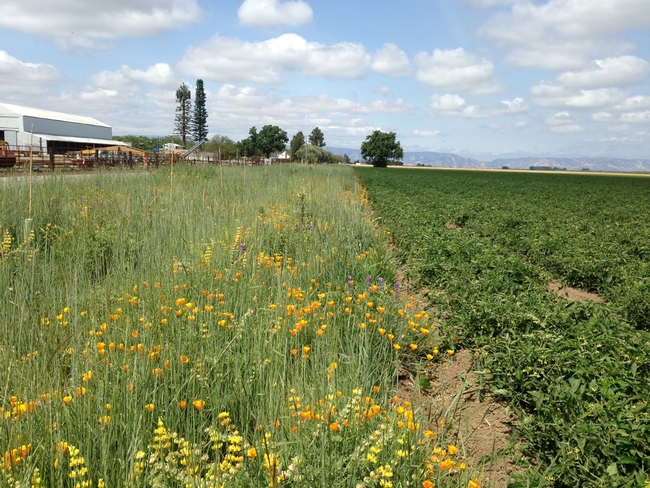How wildflower plantings on farms benefit bees and crop pollination
Bloom where you're planted.
That old adage takes on more meaning when you plant wildflower strips on your farm. Wildflowers add resilience to our farming systems by providing bees with habitat and food - pollen and nectar. And they're not just for honey bees. Many native bees, such as bumble bees and blue orchard bees, are important crop pollinators. Currently about a third of our crops benefit from bee pollination. This includes vegetables, fruit and nuts, as well as crops grown for seed production, including sunflower, melon, and carrot.
Farmers primarily rely on honey bees for crop pollination; generally two colonies per acre are needed. Honey bees are efficient pollinators, but with colony collapse and increasing colony losses, we must diversify our farming systems so we don't rely solely on honey bees.
Some important native bee crop pollinators include bumble bees, sunflower bees, squash bees, mason bees (blue orchard bees, which pollinate almonds, are mason bees) and leafcutter bees.
The benefits of native bees? Generally they forage on flowers earlier in the day than honey bees do, they tolerate more wind and cooler temperatures and often they're more efficient at gathering and moving pollen from one flower to another. Native bees also prompt honey bees to disperse more, resulting in more pollinator efficiency. All this is important for good pollination and crop production, especially for crops like almonds that bloom in late winter when the weather is more unpredictable.
Many native bees, including squash bees, nest in the soil, generally excavating chambers about 12 inches deep, where they pack cells with pollen for their young. Bumble bees often occupy vacated rodent holes. Leafcutter bees nest in woody cavities, often taking advantage of old beetle galleries. Discing and land clearing removes their nesting sites and potential food sources, but if you add wildflower plantings and hedgerows of flowering shrubs on your farm, that brings them back. Farms with strips of flowers along field edges have higher numbers of native bees than those that do not. Honey bees also benefit from better nutrition from flowers, strengthening their resiliency to pests, diseases, and pesticides.
A recent study, Pest Control and Pollination Cost–Benefit Analysis of Hedgerow Restoration in a Simplified Agricultural Landscape, published by UC Agriculture and Natural Resources (UC ANR) and UC Berkeley, describes the economic value of these plantings. Generally, a $4,000 investment to plant a 1,000-foot hedgerow of native California plants, takes about seven years to pay off from enhanced pest control and pollination services from natural enemies and bees (where honey bees are limiting). If cost-share funding is available from the USDA, this will reduce the investment cost for the restoration and time on returns.
Although habitat plantings are definitely beneficial, some farmers have expressed concern that these plantings will bring in more pests, including rodents, birds and weeds. However, current UC ANR studies show strips of flowers on field edges export beneficial insects into adjacent crops for enhanced pest control. The wildflower strips are too small to support large numbers of rodents or flocking birds that can damage crops (with the possible exception of ground squirrels and cottontail rabbits), and weeds requiring management are present regardless of field edge habitat.
Water? Although it's hot and dry out right now, many wildflowers do not need summer water. This includes Bolander's sunflower (great for songbirds like goldfinches, but the seeds should not be included in row crop mixes as they will cross-pollinate with our hybrid sunflower seeds), milkweed (great for monarch butterflies), vinegarweed, tarweed, gumplant, turkey mullein (doves love these seeds), and summer lupine. Bees, including natives and honey bees, thrive on these hardy flowers, especially now that the growing season is ending, and few crops are blooming.
Look for more information on wildflower and hedgerow plantings on the Hedgerow Hub website, , the Xerces Society website, and UC Davis fact sheet Habitat for bees and beneficials.
Networking is important too. A recent UC ANR survey showed that networking among growers, landowners, and conservation agencies is crucial in the adoption and implementation of new ideas, such as wildflower plantings.
Bottom line: Wildflower strips can ensure a healthy, sustainable food supply for crops that rely on bee pollination. “Bloom where you're planted” equals “Reap what you sow.”
Comments:
Thank you kindly





Posted by Rod G on September 11, 2016 at 5:23 PM